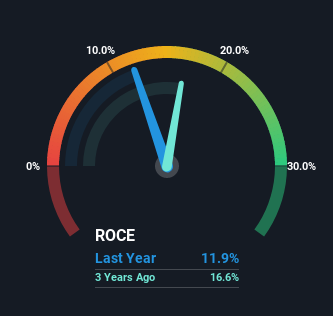- India
- /
- Construction
- /
- NSEI:SKIPPER
Skipper (NSE:SKIPPER) Will Be Hoping To Turn Its Returns On Capital Around

What are the early trends we should look for to identify a stock that could multiply in value over the long term? Ideally, a business will show two trends; firstly a growing return on capital employed (ROCE) and secondly, an increasing amount of capital employed. Ultimately, this demonstrates that it's a business that is reinvesting profits at increasing rates of return. However, after investigating Skipper (NSE:SKIPPER), we don't think it's current trends fit the mold of a multi-bagger.
Return On Capital Employed (ROCE): What Is It?
For those that aren't sure what ROCE is, it measures the amount of pre-tax profits a company can generate from the capital employed in its business. To calculate this metric for Skipper, this is the formula:
Return on Capital Employed = Earnings Before Interest and Tax (EBIT) ÷ (Total Assets - Current Liabilities)
0.12 = ₹1.3b ÷ (₹22b - ₹11b) (Based on the trailing twelve months to September 2022).
Therefore, Skipper has an ROCE of 12%. That's a relatively normal return on capital, and it's around the 11% generated by the Construction industry.
Check out our latest analysis for Skipper

Historical performance is a great place to start when researching a stock so above you can see the gauge for Skipper's ROCE against it's prior returns. If you want to delve into the historical earnings, revenue and cash flow of Skipper, check out these free graphs here.
What Can We Tell From Skipper's ROCE Trend?
On the surface, the trend of ROCE at Skipper doesn't inspire confidence. Over the last five years, returns on capital have decreased to 12% from 26% five years ago. However it looks like Skipper might be reinvesting for long term growth because while capital employed has increased, the company's sales haven't changed much in the last 12 months. It may take some time before the company starts to see any change in earnings from these investments.
On a separate but related note, it's important to know that Skipper has a current liabilities to total assets ratio of 52%, which we'd consider pretty high. This effectively means that suppliers (or short-term creditors) are funding a large portion of the business, so just be aware that this can introduce some elements of risk. Ideally we'd like to see this reduce as that would mean fewer obligations bearing risks.
The Bottom Line On Skipper's ROCE
To conclude, we've found that Skipper is reinvesting in the business, but returns have been falling. Since the stock has declined 46% over the last five years, investors may not be too optimistic on this trend improving either. Therefore based on the analysis done in this article, we don't think Skipper has the makings of a multi-bagger.
Skipper does have some risks though, and we've spotted 3 warning signs for Skipper that you might be interested in.
While Skipper isn't earning the highest return, check out this free list of companies that are earning high returns on equity with solid balance sheets.
New: Manage All Your Stock Portfolios in One Place
We've created the ultimate portfolio companion for stock investors, and it's free.
• Connect an unlimited number of Portfolios and see your total in one currency
• Be alerted to new Warning Signs or Risks via email or mobile
• Track the Fair Value of your stocks
Have feedback on this article? Concerned about the content? Get in touch with us directly. Alternatively, email editorial-team (at) simplywallst.com.
This article by Simply Wall St is general in nature. We provide commentary based on historical data and analyst forecasts only using an unbiased methodology and our articles are not intended to be financial advice. It does not constitute a recommendation to buy or sell any stock, and does not take account of your objectives, or your financial situation. We aim to bring you long-term focused analysis driven by fundamental data. Note that our analysis may not factor in the latest price-sensitive company announcements or qualitative material. Simply Wall St has no position in any stocks mentioned.
About NSEI:SKIPPER
Skipper
Manufactures and sells transmission and distribution structures, telecom towers, and fasteners in India.
Solid track record with reasonable growth potential.
Similar Companies
Market Insights
Community Narratives




